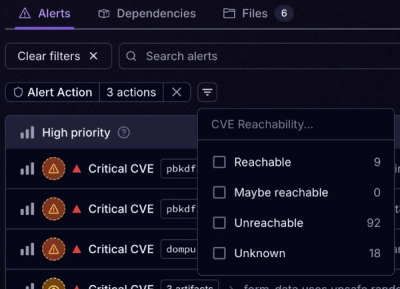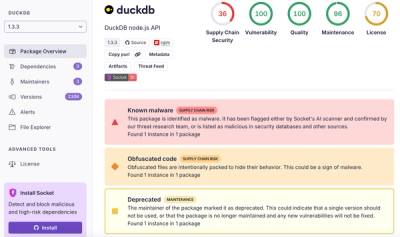
Product
Introducing Tier 1 Reachability: Precision CVE Triage for Enterprise Teams
Socket’s new Tier 1 Reachability filters out up to 80% of irrelevant CVEs, so security teams can focus on the vulnerabilities that matter.
makeup-navigation-emitter
Advanced tools
Emits custom events based on keyboard navigation of one or two dimensional model
Emits custom navigationModelChange event when keyboard navigation keys (e.g ARROW-UP, ARROW-DOWN) occur on given array of elements, their container element or other associated owner.
This module can be used as the underlying logic & state for both roving-tabindex and active-descendant (hierarchical & programmatic) behaviour.
This module is still in an experimental state; until it reaches v1, all minor releases must be considered as breaking changes.
NOTE: All examples below show abstract markup examples/structures. In an effort to make clear what this module does and does not do, all examples do not include ARIA roles, state or properties.
Example support for a roving tab-index model of keyboard navigation (typical of menu and tabs patterns). The list items form a one-dimensional model of navigation.
With keyboard focus on any list item element, arrow keys will update the underlying index position in relation to the list of items.
NOTE: this module will not actually modify the DOM or change any keyboard focus, that is the job of an observer such as makeup-roving-tabindex (which consumes this module).
<div class="widget">
<ul>
<li tabindex="0">Item 0</li>
<li>Item 1</li>
<li>Item 2</li>
</ul>
</div>
import NavigationEmitter from 'makeup-navigation-emitter';
const widgetEl = document.querySelector('.widget');
var emitter = NavigationEmitter.createLinear(widgetEl, 'li'));
// the navigationModelChange event will trigger when using UP/DOWN arrow keys on any element in model
widgetEl.addEventListener('navigationModelChange', function(e) {
console.log(e.detail.fromIndex, e.detail.toIndex);
});
Example support for an active descendant model of navigation with keyboard focus on ancestor of items (typical of listbox pattern).
With keyboard focus on the widget, arrow keys will update the underlying index position in relation to the list of items.
Note that this module will not highlight the active item, that is the job of an observer such as makeup-active-descendant.
<div class="widget" tabindex="0">
<ul>
<li>Item 0</li>
<li>Item 1</li>
<li>Item 2</li>
</ul>
</div>
import NavigationEmitter from 'makeup-navigation-emitter';
const widgetEl = document.querySelector('.widget');
var emitter = NavigationEmitter.createLinear(widgetEl, 'li'));
widgetEl.addEventListener('navigationModelChange', function(e) {
console.log(e.detail.fromIndex, e.detail.toIndex);
});
Example support for an active descendant model of navigation with keyboard focus on non-ancestor of items (typical of combobox pattern).
With keyboard focus on the textbox, arrow keys will update the underlying index position in relation to the list of items.
Note that this module will not highlight the active item, that is the job of an observer such as makeup-active-descendant.
<div class="widget">
<input type="text" />
<ul>
<li>Item 0</li>
<li>Item 1</li>
<li>Item 2</li>
</ul>
</div>
import NavigationEmitter from 'makeup-navigation-emitter';
const widgetEl = document.querySelector('.widget');
var emitter = NavigationEmitter.createLinear(widgetEl, 'li', { autoInit: 'none', autoReset: 'none' }));
widgetEl.addEventListener('navigationModelChange', function(e) {
console.log(e.detail.fromIndex, e.detail.toIndex);
});
autoInit: declares the initial item (default: "interactive"). Possible values are:
autoReset: declares the item after a reset and/or when keyboard focus exits the widget (default: "current"). Possible values are:
axis : specify 'x' for left/right arrow keys, 'y' for up/down arrow keys, or 'both' (default: 'both')ignoreByDelegateSelector: CSS selector of descendant elements that will be ignored by the key event delegation (i.e. these elements will not operate the navigation emitter) (default: null)wrap : specify whether arrow keys should wrap/loop (default: false)destroy: destroys all event listenersreset: will force a reset to the value specified by autoResetmatchingItems: returns all items that match item selectornavigableItems: returns navigable subset of matchingItems (e.g. non-hidden & non aria-disabled items)navigationModelInit - fired when the model is auto initialised (bubbles: false)navigationModelChange - fired when the index is set by any means other than auto init or auto reset (bubbles: false)navigationModelReset - fired when the model is auto reset (bubbles: false)navigationModelMutation - fired when any changes to the elements DOM (bubbles: false)FAQs
Did you know?

Socket for GitHub automatically highlights issues in each pull request and monitors the health of all your open source dependencies. Discover the contents of your packages and block harmful activity before you install or update your dependencies.

Product
Socket’s new Tier 1 Reachability filters out up to 80% of irrelevant CVEs, so security teams can focus on the vulnerabilities that matter.

Research
/Security News
Ongoing npm supply chain attack spreads to DuckDB: multiple packages compromised with the same wallet-drainer malware.

Security News
The MCP Steering Committee has launched the official MCP Registry in preview, a central hub for discovering and publishing MCP servers.